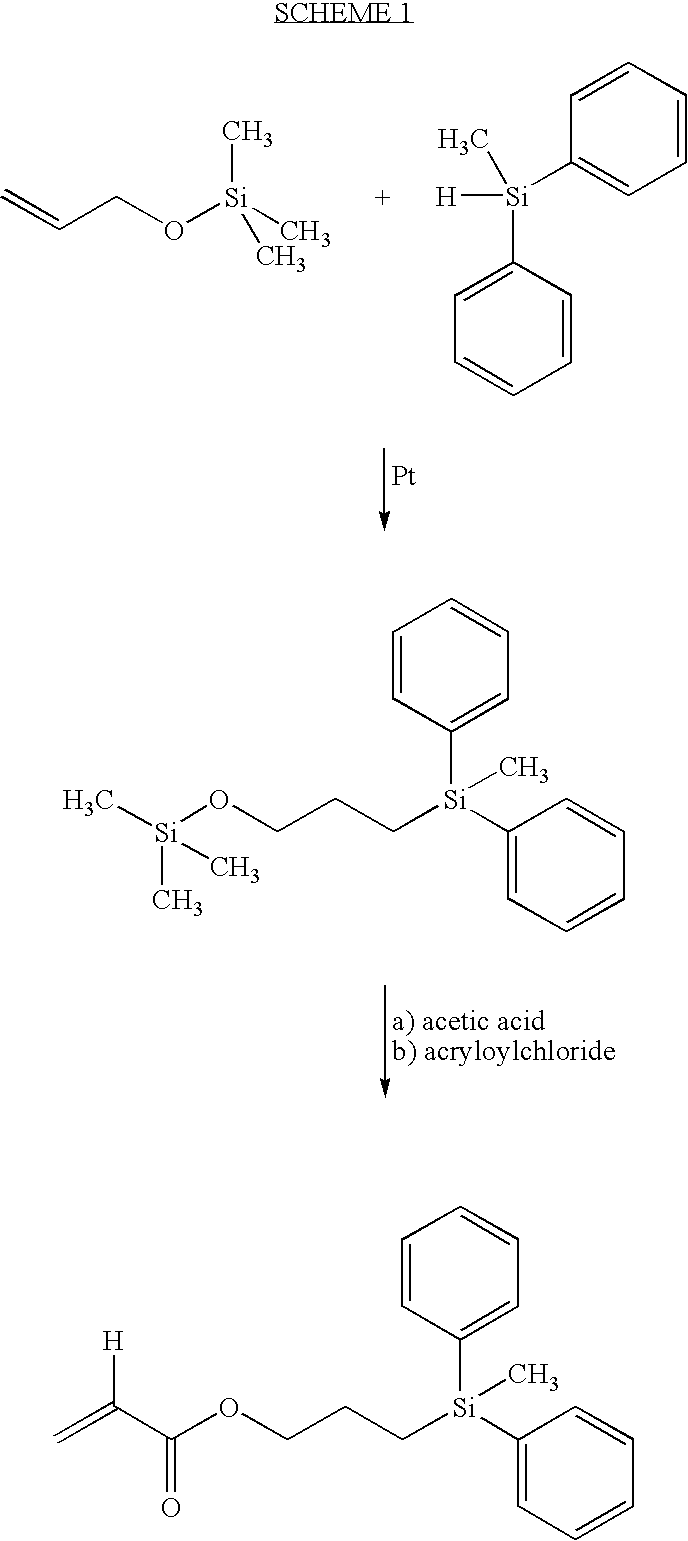High refractive index aromatic-based silyl monomers
a technology of aromatic-based silyl monomers and high refractive index, which is applied in the field of monomers, can solve the problems of less popularization of rigid iol implants in the market, increased incidence of postoperative complications, and less desirable than other materials with respect to minimal incision size, and achieves the effect of economic production
- Summary
- Abstract
- Description
- Claims
- Application Information
AI Technical Summary
Benefits of technology
Problems solved by technology
Method used
Image
Examples
example 1
Three-step Synthesis of 3-acryloyloxypropydiphenyl-methylsilane (APDMS)
Step One
Synthesis of 3-(trimethylsilyloxy)propyldiphenylmethylsilane
In a two liter acid washed round bottom flask equipped with magnesium stirrer, condenser and dry air tube was placed 100 g of diphenylmethylsilane, (0.5042 moles), 656.7 g of trimethylsilylallyl (TMS-allyl) alcohol (5.042 moles) and 1000 μl of Pt catalyst (Aldrich Chemical Co. 47,951-9). The solution was refluxed for 16 hours, cooled to room temperature and 20 g of silica gel was added. Stirring was continued for 2 hours. The mixture was filtered and rotovapped to oil. The oil was vacuum distilled (boiling point (b.p.) 110-15° C. at 0.1 mm Hg). Recovered 158 g (GC-97%) yield 95%.
Step Two
Synthesis of 3-hydroxypropyldiphenylmethylsilane
In a one liter erylenmeyer flask was placed 161 g of the product from step one above (0.4901 mole) dissolved in 700 ml of methanol. To the above was slowly added 35 ml of distilled water followed by 4 ml of glacial a...
example 2
To 65 parts of 3phenylpropyl acrylate (PPA) was added 25 parts of N,N-dimethylacrylamide, 20 parts of hexanol, 10 parts of APDMS, 3 parts of ethyleneglycol dimethacrylate and 0.5% of Irgacure™ 819 as the UV photoinitiator and 0.25% of a commercial triazole UV blocker (Aldrich Chemical Co). The clear solution was sandwiched between two silanized glass plates using metal gaskets and exposed to UV radiation for two hours. The resultant films were released extracted in isopropanol (IPA) for four hours, followed by air-drying and a 30 mm vacuum to remove the IPA. The resultant film was hydrated at room temperature overnight in borate buffered saline. The clear task-free films possessed a modulus of 81 g / mm2, a tear strength of 77 g / mm, a % elongation of 228%, a water content of 5% and a refractive index of 1.5442.
example 3
To 70 parts of APDMS was added 10 parts of N,N-dimethylacrylamide, 20 parts of hexanol, 1 part of ethyleneglycol dimethacrylate and 0.5% of Irgacure™ 819 as the UV photoinitiator and 0.25% of a commercial triazole UV blocker (Aldrich Chemical Co). The clear solution was sandwiched between two silanized glass plates using metal gaskets and exposed to UV radiation for two hours. The resultant films were released and extracted in IPA for four hours, followed by air-drying and a 30 mm vacuum to remove the IPA. The resultant film was hydrated at room temperature overnight in borate buffered saline. The clear tack-free films possessed a modulus of 161 g / mm2, a tear strength of 64 g / mm, a % elongation of 183%, a water content of 10.5 % and a refractive index of 1.517.
Ophthalmic devices such as but not limited to IOLs manufactured using the polymeric compositions of the present invention can be of any design capable of being rolled or folded for implantation through a relatively small surgi...
PUM
| Property | Measurement | Unit |
|---|---|---|
| Hydrophilicity | aaaaa | aaaaa |
| Hydrophobicity | aaaaa | aaaaa |
Abstract
Description
Claims
Application Information
 Login to View More
Login to View More - R&D
- Intellectual Property
- Life Sciences
- Materials
- Tech Scout
- Unparalleled Data Quality
- Higher Quality Content
- 60% Fewer Hallucinations
Browse by: Latest US Patents, China's latest patents, Technical Efficacy Thesaurus, Application Domain, Technology Topic, Popular Technical Reports.
© 2025 PatSnap. All rights reserved.Legal|Privacy policy|Modern Slavery Act Transparency Statement|Sitemap|About US| Contact US: help@patsnap.com



